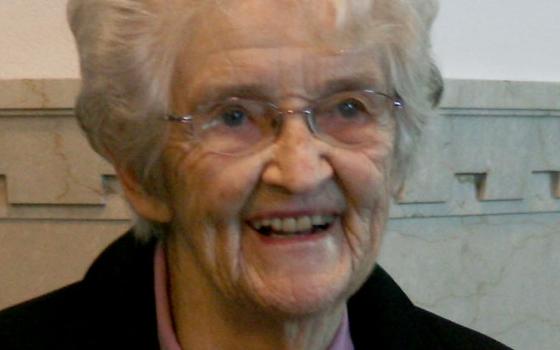Commentary - I have always had a tremendous fear of death. It arose, perhaps, from having had older parents. I worried my parents might die, leaving me bereft. Even now, I sometimes awake at night gripped by the terrible anxiety that I will soon die.
At this time of year when Christians celebrate the death and resurrection of Jesus – the promise that another life, an eternal life, flows from this one – I feel as though I need to slink in some corner and conceal my satchel full of doubts. I feel like a fraudulent Christian.
However, if we are lucky in life, we arrive at a moment that launches us on a journey of discovery. In the summer of 2008, seeking to live a more contemplative life as a married, professional woman, I began making regular visits to Mount St. Scholastica, a Benedictine women’s monastery in Atchison, Kan.
One of the first friends I made there was 90-year-old Sr. Lillian Harrington.
Sr. Lillian’s impish wit shone through from the start. She walked with the assistance of a cane. When I asked if she ever traveled to my home state of Illinois, she quipped, “Oh, I don’t leave the monastery much anymore. I don’t want people to have to carry me too far.”
I spent a good deal of time with Sr. Lillian on that first visit. One day, I finally drew up the courage to ask her if, at her advanced age, she ever thinks about the moment of death. She drilled her steely blue eyes into mine and told me something I’ve never forgotten:
“I don’t think about dying,” she said. “I think about living.”
The way she lived her life convinced me that was true. At 75, after retiring as a professor of speech and drama, Sr. Lillian reinvented herself as the “Pilgrim Minister.” She traveled to schools, parishes and retreat centers dramatizing Gospel passages and other wisdom stories. One of her crowd-pleasers was her adaptation of the Martha and Mary story. A wisp of a woman with a shock of white hair, she would don one color veil, then another as she switched roles from Martha to Mary.
She performed without notes or a script, well into her 90s.
Every evening without fail, Sr. Lillian visited her sister Mary Cummings who lived in the monastery’s assisted living wing. Cummings, 11 years older, had taught Sr. Lillian in the one-room school they had attended near their family’s farm in Blaine, Kan.
Mary’s life had taken a different path. She had married and bore six children. When Mary suffered a stroke at the age of 99, Sr. Lillian arranged to care for her at the monastery.
Each night around nine, Sr. Lillian would hobble to a small kitchenette and prepare a sandwich of bread, butter and jelly for Mary. Then, she would read to her, until one or the other of them nodded off to sleep.
When Mary died on Thanksgiving Day in 2011 at the age of 104, Sr. Lillian was at her bedside.
Last year, just before her 95th birthday, doctors told Sr. Lillian some of her organs were breaking down. She said she went to bed that night repeating, “I am not going to die. I’m going to live.”
Sr. Lillian celebrated her 96th birthday in March by washing down a chunk of ice cream cake with a strawberry daiquiri. Dressed in a pale green suit, she sat in a wheelchair in the monastery’s dining room, accepting greetings from friends, former students and members of her monastic community like a monarch on her throne.
Five days later, she lapsed into a coma. She died within hours, surrounded by her Benedictine sisters in the monastery where she had lived for 79 years.
Despite her age, her death came as a shock. Most of us thought she’d match her sister Mary and live to 104.
The chapel where Sr. Lillian’s wake took place holds 500 people. Nearly every seat was filled. They came from all parts of the country. Former students, many now in their 70s. Retreat participants she had befriended, priests she had mentored. Even her former students’ grandchildren, who’d been beguiled by the stories she wove as they sat at her feet.
“Most sisters who die at Lillian’s age have only the members of their religious community at their funeral,” one sister remarked. Sr. Lillian’s friendships spanned the generations. She had never stopped making friends. She had not once ceased to serve.
Reflecting on Sr. Lillian’s life, I feel relieved of my fear of death. It’s not because I’m suddenly certain that there’s an afterlife. Even Sr. Lillian once remarked, “None of us knows what happens after we die. We just believe.”
Sr. Lillian’s death made me realize I’ve been asking the wrong question. The real question is not whether there is life after death, but whether there is life before death. With a life well-lived in service and friendship, when that moment does come, I trust I’ll have nothing to fear.
[Judith Valente is a poet, a correspondent for Religion & Ethics News Weekly on PBS and commentator for WGLT-Radio in Illinois. Her latest book, Atchison Blue: A Search for Silence, a Spiritual Home and a Living Faith, chronicles her many visits with the Benedictine sisters of Mount St. Scholastica, a monastery in Atchison, Kan.]

